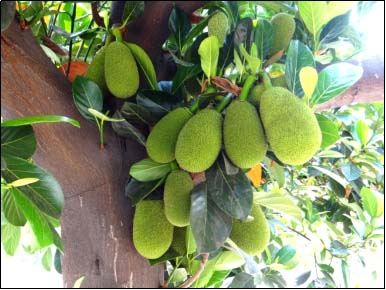Introduction –
Jackfruit is also known as Jack tree. It is originated in the Indo-Malayan region and grown mostly in tropical & Sub Tropical, high rainfall, coastal and humid areas of the world. Beside India the major cultivation is also in countries like Bangladesh, Myanmar, Nepal, Thailand, Vietnam, China, Philippines, Indonesia, Malaysia and Sri Lanka.
It is cultivated in an area up to an elevation of 1200 m for multi-purposes such as food, timber, fuel, fodder, medicinal and industrial use.
Jackfruit is well adapted in humid tropical climates. It is sensitive to frost in its early life and cannot tolerate drought condition for long period. Jackfruit can grow on a wide variety of soil, but deep rich alluvial & loamy soil is ideal for its cultivation with slightly acidic pH ranging between 6 – 6.5. In India the major growing states of Jackfruit is Kerala, Tamil Nadu, Odisha, West Bengal, Assam, Bihar and Uttar Pradesh.
SCIENTIFIC CLASSIFICATION
| Kingdom | Plantae |
| Division | Mangnoliophyta |
| Class | Magnoliopsida |
| Order | Rosale |
| Family | Moraceae |
| Genus | Artocarpus |
| Species | heterophyllus |
| Botanical Name | Artocarpus heterophyllus |
REQUIREMENTS:
- Soil – It can be grown in a wide variety of soil but loamy soil with well drained and proper aeration is best for cultivation.
- pH – The ideal pH for Jackfruit cultivation is 6.0 to 6.5 however it can tolerate maximum of 8.5 pH and minimum of 4.0 pH.
- Temperature – Optimum temperature for growth is about 30 – 400 C. It can tolerate up to 450 C.
- Elevation – It can be cultivated successfully up to an elevation of 1200 meter above mean sea level.
- Climate – It is hardy in nature and performs well in drought, semi-arid and subtropical conditions.
- Irrigation Water – The EC of water should be less than 1.0 dSm-1 for its successful cultivation.
NUTRIONAL COMPOSITION OF YOUNG AND RIPE FRUIT (100 g fruit)
| Composition | Unit | Young Fruit | Ripe Fruit |
| Water | g | 76.2 – 85.2 | 72.0 – 94.0 |
| Protein | g | 02.0 – 02.6 | 01.2 – 01.9 |
| Fat | g | 00.1 – 00.6 | 00.1 – 00.4 |
| Carbohydrate | g | 09.4 – 11.5 | 16.0 – 25.4 |
| Fibre | g | 02.6 – 03.6 | 01.0 – 01.5 |
| Total sugars | g | – | 20.6 |
| Total minerals | g | 0.9 | 0.87 – 00.9 |
| Calcium | Mg | 30.0 – 73.2 | 20.0 – 37.0 |
| Magnesium | Mg | – | – |
| Phosphorus | Mg | 20.0 – 57.2 | 38.0 – 41.0 |
| Potassium | Mg | 287 – 323 | 191 – 407 |
| Sodium | Mg | 03.0 – 35.0 | 02.0 – 41.0 |
| Iron | Mg | 00.4 – 01.9 | 00.5 – 01.1 |
| Vitamin A | IU | 30 | 175 – 540 |
HEALTH BENEFITS:
| 1. It reduces the risk of heart disease by increasing LDL:HDL ratio. |
| 2. It reduces the risk of high blood pressure & strokes. |
| 3. It protects the skin from damage due to good Vitamin C content. |
| 4. Phytonutrients in Jackfruit contribute to its Anti cancerous properties. |
| 5. Dietary fibre content helps in relieving bowel problems. |
| 6. It is also known for its antifungal & antibacterial properties. |
| 7. High calcium content of Jackfruit prevents bone related disorder such as osteoporosis. |
VNR Jackfruit
VNR Jackfruit variety is researched and developed by “Krishi Pandit”
Dr. Narayan Chawda. It is precocious, high yielding with less gum, making it preferable for the vegetable users.

The Package of practices are prepared in following order –
– Care of Young Plant of VNR Jackfruit Before Plantation
– Plantation and Earthing Up of VNR Jackfruit Plants
– Placement of Drip Laterals in VNR Jackfruit Orchard
– Staking of VNR Jackfruit Plants
– Removal of Tape From Graft Union of VNR Jackfruit Plants
– Training of VNR Jackfruit Plants
– Pruning of VNR Jackfruit Plants
– Flowering & Polination in VNR Jackfruit Plants
– Harvesting of VNR Jackfruit Plant
– Insect Pest and Disease Managment of VNR Jackfruit
Reference:
https://www.ncbi.nlm.nih.gov/pmc/articles/PMC6339770/
https://www.researchgate.net/publication/330201154_Nutritional_and_Health_Benefits_of_Jackfruit_Artocarpus_heterophyllus_Lam_A_Review









